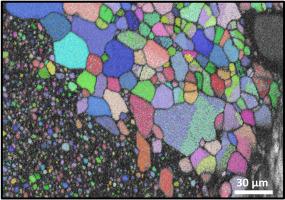Boron induced abnormal grain growth in alumina
IF 2.9
Q1 MATERIALS SCIENCE, CERAMICS
引用次数: 0
Abstract
In this work, hot-pressing of alumina in contact with hexagonal boron nitride or doped with boron carbide was conducted at 1500 °C for 30 min. After hot-pressing, abnormal grain growth induced by boron diffusion from these substances into alumina was detected, as clearly demonstrated with SEM, EDS, EBSD, and Raman spectroscopy. Grain boundary complexion transformations, solute drag, or another mechanism relating to interface-controlled grain boundary mobility are presumed to be the fundamental mechanism responsible for abnormal grain growth observed in this work.

硼诱导氧化铝中的异常晶粒生长
在这项工作中,在 1500 °C 下对接触六方氮化硼或掺杂碳化硼的氧化铝进行了 30 分钟的热压。热压后,检测到硼从这些物质扩散到氧化铝中引起的异常晶粒生长,这一点在 SEM、EDS、EBSD 和拉曼光谱中都有清楚的证明。据推测,晶界复合转化、溶质拖曳或与界面控制晶界流动性有关的其他机制是导致本研究中观察到的异常晶粒生长的基本机制。
本文章由计算机程序翻译,如有差异,请以英文原文为准。
求助全文
约1分钟内获得全文
求助全文
来源期刊

Open Ceramics
Materials Science-Materials Chemistry
CiteScore
4.20
自引率
0.00%
发文量
102
审稿时长
67 days
 求助内容:
求助内容: 应助结果提醒方式:
应助结果提醒方式:


